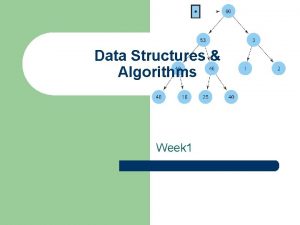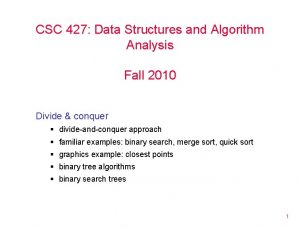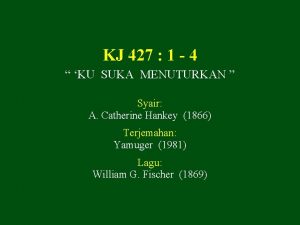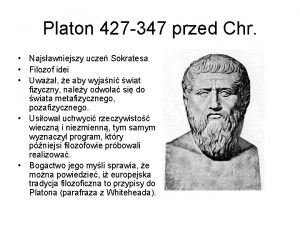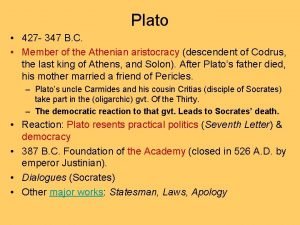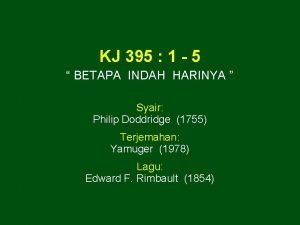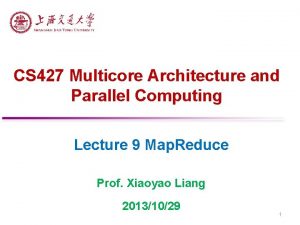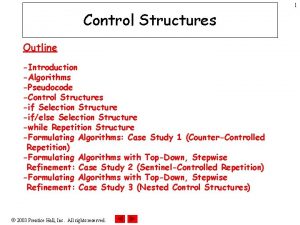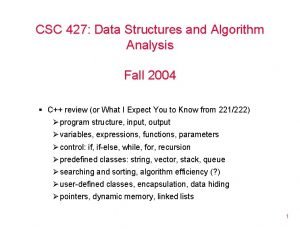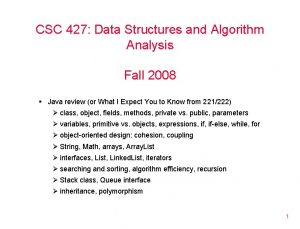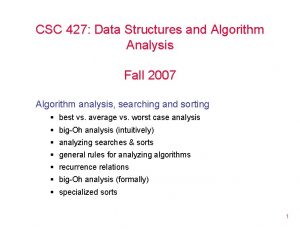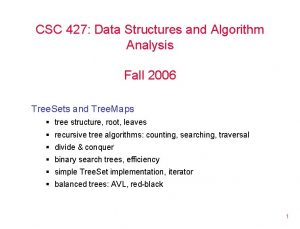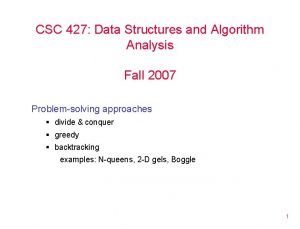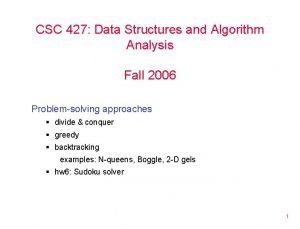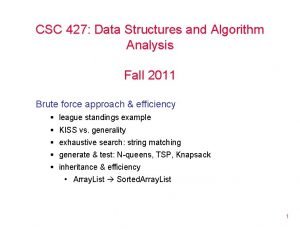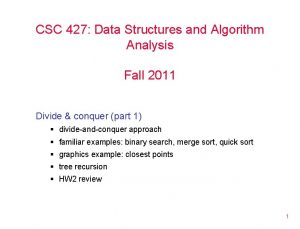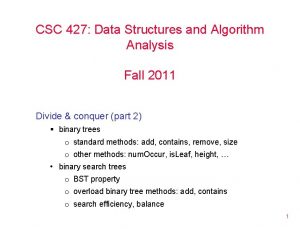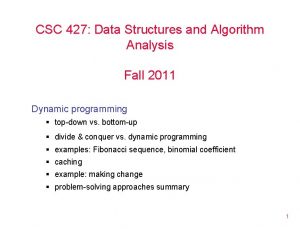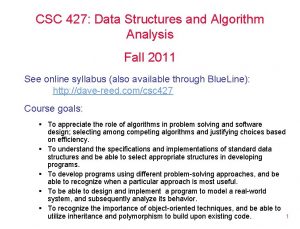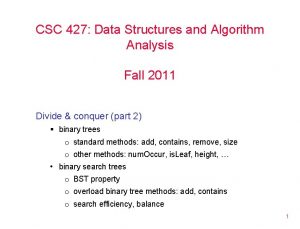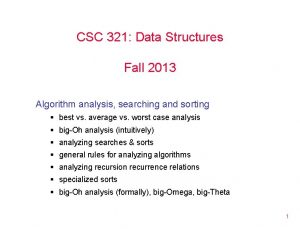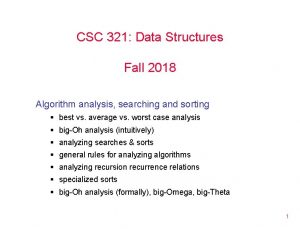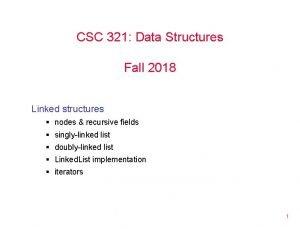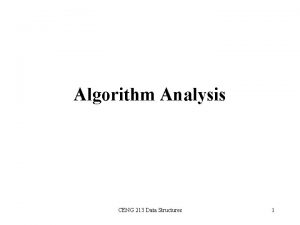CSC 427 Data Structures and Algorithm Analysis Fall


































- Slides: 34

CSC 427: Data Structures and Algorithm Analysis Fall 2010 Divide & conquer § divide-and-conquer approach § familiar examples: binary search, merge sort, quick sort § graphics example: closest points § binary tree algorithms § binary search trees 1

X & Conquer algorithms many algorithms solve a problem by breaking it into subproblems, solving each subproblem (often recursively), then combining the results § if the subproblem is proportional to the list size (e. g. , half), we call it divide-and-conquer § if the subproblem is reduced in size by a constant amount, we call it decrease-and-conquer § if the subproblem is a transformation into a simpler/related divide-and-conquer probably the best known algorithmic problem, we call itistransform-and-conquer approach e. g. , binary search as divide-and-conquer 1. if list size = 0, then FAILURE 2. otherwise, check midpoint of list a) if middle element is the item being searched for, then SUCCESS b) if middle element is > item being searched for, then binary search the left half c) if middle element is < item being searched for, then binary search the right half 2

Iteration vs. divide & conquer many iterative algorithms can be characterized as divide-andconquer § sum of list[0. . N-1] = 0 list[N/2] + sum of list [0. . N/2 -1] + sum of list[N/2+1. . N-1] if N == 0 otherwise § number of occurrences of X in list[0. . N-1] = 0 if N == 0 1 + num of occurrences of X in list[0. . N/2 -1] + if X == list[N/2] + num of occurrences of X in list[N/2+1. . N-1] 0 + num of occurrences of X in list[0. . N/2 -1] + if X != list[N/2] + num of occurrences of X in list[N/2+1. . N-1] recall: Cost(N) = 2 Cost(N/2) + C O(N), so no real advantage 3

Merge sort we have seen divide-and-conquer algorithms that are more efficient than brute force e. g. , merge sort list[0. . N-1] 1. if list N <= 1, then DONE 2. otherwise, a) merge sort list[0. . N/2] b) merge sort list[N/2+1. . N-1] c) merge the two sorted halves recall: Cost(N) = 2 Cost(N/2) +CN O(N log N) § merging is O(N), but requires O(N) additional storage and copying 4

Quick sort Collections. sort implements quick sort, another O(N log ) sort which is faster in practice e. g. , quick sort list[0. . N-1] 1. if list N <= 1, then DONE 2. otherwise, a) select a pivot element (e. g. , list[0], list[N/2], list[random], …) b) partition list into [items < pivot] + [items == pivot] + [items > pivot] c) quick sort the < and > partitions best case: pivot is median Cost(N) = 2 Cost(N/2) +CN O(N log N) worst case: pivot is smallest or largest value Cost(N) = Cost(N-1) +CN O(N 2) 5

Quick sort (cont. ) average case: O(N log N) there are variations that make the worst case even more unlikely § switch to selection sort when small (as in HW 3) § median-of-three partitioning instead of just taking the first item (or a random item) as pivot, take the median of the first, middle, and last items in the list if the list is partially sorted, the middle element will be close to the overall median if the list is random, then the odds of selecting an item near the median is improved refinements like these can improve runtime by 20 -25% however, O(N 2) degradation is possible 6

Closest pair given a set of N points, find the pair with minimum distance § brute force approach: consider every pair of points, compare distances & take minimum big Oh? O(N 2) § there exists an O(N log N) divide-andconquer solution 1. sort the points by x-coordinate 2. partition the points into equal parts using a vertical line in the plane 3. recursively determine the closest pair on left side (Ldist) and the closest pair on the right side (Rdist) 4. find closest pair that straddles the line, each within min(Ldist, Rdist) of the line (can be done in O(N)) 5. answer = min(Ldist, Rdist, Cdist) 7

Trees & divide-and-conquer a tree is a nonlinear data structure consisting of nodes (structures containing data) and edges (connections between nodes), § onesuch node, that: the root, has no parent (node connected from above) § every other node has exactly one parent node § there is a unique path from the root to each node (i. e. , the tree is connected and there are no cycles) nodes that have no children (nodes connected below them) are known as leaves 8

Recursive definition of a trees are naturally recursive data structures: § the empty tree (with no nodes) is a tree § a node with subtrees connected below is a tree empty tree with 1 node (empty subtrees) tree with 7 nodes a tree where each node has at most 2 subtrees (children) is a binary tree 9

Trees in CS trees are fundamental data structures in computer science example: file structure § an OS will maintain a directory/file hierarchy as a tree structure § files are stored as leaves; directories are stored as internal (non-leaf) nodes descending down the hierarchy to a subdirectory traversing an edge down to a child node DISCLAIMER: directories contain links back to their parent directories, so not strictly a tree 10

Recursively listing files to traverse an arbitrary directory structure, need recursion to list a file system object (either a directory or file): 1. print the name of the current object 2. if the object is a directory, then ─ recursively list each file system object in the directory in pseudocode: public static void List. All(File. System. Object current) { System. out. println(current. get. Name()); if (current. is. Directory()) { for (File. System. Object obj : current. get. Contents()) { List. All(obj); } } } 11

Recursively listing files public static void List. All(File. System. Object current) { System. out. println(current. get. Name()); if (current. is. Directory()) { for (File. System. Object obj : current. get. Contents()) { List. All(obj); } } } this method performs a preorder traversal: prints the root first, then the subtrees 12

UNIX du command in UNIX, the du command list the size of all files and directories from the ~davereed directory: unix> du –a 2. /public_html/index. html 3. /public_html/Images/reed. jpg 3. /public_html/Images/logo. gif 7. /public_html/Images 10. /public_html 1. /mail/dead. letter 2. /mail 13. public static int du(File. System. Object current) { int size = current. block. Size(); if (current. is. Directory()) { for (File. System. Object obj : current. get. Contents()) { size += du(obj); } } System. out. println(size + " " + current. get. Name()); return size; } this method performs a post-order traversal: prints the subtrees first, then the root 13

Dividing & conquering trees since trees are recursive structures, most tree traversal and manipulation operations can be classified as divide & conquer algorithms § § can divide a tree into root + left subtree + right subtree most tree operations handle the root as a special case, then recursively process the subtrees § e. g. , to display all the values in a (nonempty) binary tree, divide into 1. displaying the root 2. (recursively) displaying all the values in the left subtree 3. (recursively) displaying all the values in the right subtree § e. g. , to count number of nodes in a (nonempty) binary tree, divide into 1. (recursively) counting the nodes in the left subtree 2. (recursively) counting the nodes in the right subtree 3. adding the two counts + 1 for the root 14

Binary. Tree class public class Binary. Tree<E> { protected Tree. Node root; public Binary. Tree() { this. root = null; } public void add(E value) { … } to implement a binary tree, need to store the root node § the empty tree has a null root § then, must implement methods for basic operations on the collection public boolean remove(E value) { … } public boolean contains(E value) { … } public int size() { … } public String to. String() { … } } 15

size method divide-and-conquer approach: BASE CASE: if the tree is empty, number of nodes is 0 RECURSIVE: otherwise, number of nodes is (# nodes in left subtree) + (# nodes in right subtree) + 1 for the root note: a recursive implementation requires passing the root as parameter § will have a public "front" method, which calls the recursive "worker" public int size() { method return this. size(this. root); } private int size(Tree. Node<E> current) { if (current == null) { return 0; } else { return this. size(current. get. Left()) + this. size(current. get. Right()) + 1; } } 16

contains method divide-and-conquer approach: BASE CASE: if the tree is empty, the item is not found BASE CASE: otherwise, if the item is at the root, then found RECURSIVE: otherwise, search the left and then right subtrees public boolean contains(E value) { return this. contains(this. root, value); } private boolean contains(Tree. Node<E> current, E value) { if (current == null) { return false; } else { return value. equals(current. get. Data()) || this. contains(current. get. Left(), value) || this. contains(current. get. Right(), value); } } 17

to. String method must traverse the entire tree and build a string of the items § there are numerous patterns that can be used, e. g. , in-order traversal BASE CASE: if the tree is empty, then nothing to traverse RECURSIVE: recursively traverse the left subtree, then access the root, thento. String() recursively traverse the right subtree public String { if (this. root == null) { return "[]"; } String rec. Str = this. to. String(this. root); return "[" + rec. Str. substring(0, rec. Str. length()-1) + "]"; } private String to. String(Tree. Node<E> current) { if (current == null) { return ""; } return this. to. String(current. get. Left()) + current. get. Data(). to. String() + ", " + this. to. String(current. get. Right()); } 18

Alternative traversal algorithms pre-order traversal: BASE CASE: if the tree is empty, then nothing to traverse RECURSIVE: access root, recursively traverse left subtree, then right subtree post-order traversal: BASE CASE: if the tree is empty, then nothing to traverse RECURSIVE: recursively traverse left subtree, then right subtree, then root private String to. String(Tree. Node<E> current) { if (current == null) { return ""; } return current. get. Data(). to. String() + ", " + this. to. String(current. get. Left()) + this. to. String(current. get. Right()); } private String to. String(Tree. Node<E> current) { if (current == null) { return ""; } return this. to. String(current. get. Left()) + this. to. String(current. get. Right()) + current. get. Data(). to. String() + ", "; } 19

Exercises /** @return the number of times value occurs in the tree with specified root */ public int num. Occur(Tree. Node<E> root, E value) { } /** @return the sum of all the values stored in the tree with specified root */ public int sum(Tree. Node<Integer> root) { } /** @return the # of nodes in the longest path from root to leaf in the tree */ public int height(Tree. Node<E> root) { } 20

add method how do you add to a binary tree? § § § ideally, would try to keep the tree balanced, but naïve approach is O(N 2) we will more consider efficient approaches for maintaining balance later public void add(E value) { for now, we will add a new value at a random leaf location this. root = this. add(this. root, value); } private Tree. Node<E> add(Tree. Node<E> current, E value) { if (current == null) { current = new Tree. Node<E>(value, null); } else if (current. get. Left() == null) { current. set. Left(new Tree. Node<E>(value, null)); } else if (current. get. Right() == null) { current. set. Right(new Tree. Node<E>(value, null)); } else if (Math. random() < 0. 5) { current. set. Left(this. add(current. get. Left(), value)); } else { current. set. Right(this. add(current. get. Right(), value)); } return current; } big. Oh? 21

remove method how do you remove from a binary tree? § § tricky, since removing an internal node means rerouting pointers must maintain binary tree structure simpler solution 1. find node (as in search) 2. if a leaf, simply remove it 3. if no left subtree, reroute parent pointer to right subtree 4. otherwise, replace current value with a leaf value from the left subtree (and remove the leaf node) you can see the implementation in Binary. Tree. java 22

Searching linked lists recall: a (linear) linked list only provides sequential access O(N) searches it is possible to obtain O(log N) searches using a tree structure in order to perform binary search efficiently, must be able to § access the middle element of the list in O(1) § divide the list into halves in O(1) and recurse HOW CAN WE GET THIS FUNCTIONALITY FROM A TREE? 23

Binary search trees a binary search tree is a binary tree in which, for every node: § the item stored at the node is ≥ all items stored in its left subtree § the item stored at the node is < all items stored in its right subtree in a (balanced) binary search tree: • middle element = root • 1 st half of list = left subtree • 2 nd half of list = right subtree furthermore, these properties hold for each subtree 24

Binary. Search. Tree class can use inheritance to derive Binary. Search. Tree from Binary. Tree public class Binary. Search. Tree<E extends Comparable<? super E>> extends Binary. Tree<E> { public Binary. Search. Tree() { super(); } public void add(E value) { // OVERRIDE TO MAINTAIN BINARY SEARCH TREE PROPERTY } public void CONTAINS(E value) { // OVERRIDE TO TAKE ADVANTAGE OF BINARY SEARCH TREE PROPERTY } public void remove(E value) { // DOES THIS NEED TO BE OVERRIDDEN? } } 25

Binary search in BSTs to search a binary search tree: 1. if the tree is empty, NOT FOUND 2. if desired item is at root, FOUND 3. if desired item < item at root, then recursively search the left subtree 4. if desired item > item at root, then recursively search the right subtree public boolean contains(E value) { return this. contains(this. root, value); } private boolean contains(Tree. Node<E> current, E value) { if (current == null) { return false; } else if (value. equals(current. get. Data())) { return true; } else if (value. compare. To(current. get. Data()) < 0) { return this. contains(current. get. Left(), value); } else { return this. contains(current. get. Right(), value); } } 26

Search efficiency how efficient is search on a BST? § in the best case? O(1) if desired item is at the root § in the worst case? O(height of the tree) root if item is leaf on the longest path from the in order to optimize worst-case behavior, want a (relatively) balanced tree § otherwise, don't get binary reduction § e. g. , consider two trees, each with 7 nodes 27

How deep is a balanced tree? THEOREM: A binary tree with height H can store up to 2 H-1 nodes. Proof (by induction): BASE CASES: when H = 0, 20 - 1 = 0 nodes when H = 1, 21 - 1 = 1 node HYPOTHESIS: assume a tree with height H-1 can store up to 2 H-1 -1 nodes INDUCTIVE STEP: a tree with height H has a root and subtrees with height up to H-1 store up to by our hypothesis, T 1 and T 2 can each 2 H-1 -1 nodes, so tree with height H can equivalently: N nodes can be log 2(N+1) 1 + (2 H-1 -1) = 2 H-1 + 2 H-1 -1 = stored in a binary tree of H 2 -1 nodes height 28

Search efficiency (cont. ) so, in a balanced binary search tree, searching is O(log N) N nodes height of log 2(N+1) in worst case, have to traverse log 2(N+1) nodes what about the average-case efficiency of searching a binary search tree? § assume that a search for each item in the tree is equally likely § take the cost of searching for each item and average those costs of search 1 2 3 + + 3 2 + 3 3 + 17/7 2. 42 define the weight of a tree to be the sum of all node depths (root = 1, …) average cost of searching a tree = weight of tree / number of nodes in 29

Search efficiency (cont. ) costs of search 1 2 3 + + 3 17/7 2. 42 2 + 3 3 + ~log N costs of search 1 +2 +3 +4 +5 +6 +7 28/7 4. 00 ~N/2 30

Inserting an item inserting into a BST 1. traverse edges as in a search 2. when you reach a leaf, add the new node below it public void add(E value) { this. root = this. add(this. root, value); } private Tree. Node<E> add(Tree. Node<E> current, E value) { if (current == null) { return new Tree. Node<E>(value, null); } if (value. compare. To(current. get. Data()) <= 0) { current. set. Left(this. add(current. get. Left(), value)); } else { current. set. Right(this. add(current. get. Right(), value)); } return current; } 31

Removing an item recall Binary. Tree remove 1. find node (as in search) 2. if a leaf, simply remove it 3. if no left subtree, reroute parent pointer to right subtree 4. otherwise, replace current value with a leaf value from the left subtree (and remove the leaf node) CLAIM: as long as you select the rightmost (i. e. , maximum) value in the left subtree, this remove algorithm maintains the BST property WHY? so, no need to override remove 32

Maintaining balance PROBLEM: random insertions (and removals) do not guarantee balance § e. g. , suppose you started with an empty tree & added words in alphabetical order braves, cubs, giants, phillies, pirates, reds, rockies, … braves cubs giants phillies with repeated insertions/removals, can degenerate so that height is O(N) § specialized algorithms exist to maintain balance & ensure O(log N) height § or take your chances 33

Balancing trees on average, N random insertions into a BST yields O(log N) height § however, degenerative cases exist (e. g. , if data is close to ordered) we can ensure logarithmic depth by maintaining balance maintaining full balance can be costly § however, full balance is not needed to ensure O(log N) operations (LATER) 34
 Explain conditional macro expansion with example
Explain conditional macro expansion with example Assembler algorithm and data structures
Assembler algorithm and data structures Data structures and algorithm
Data structures and algorithm 427 data
427 data Homologous structures definition
Homologous structures definition Umich eecs 270
Umich eecs 270 Tqpinbox
Tqpinbox Platos aesthetics
Platos aesthetics Plato 427 347 bc
Plato 427 347 bc Kj427
Kj427 Experiment 427
Experiment 427 Lesson 6 use the pythagorean theorem answer key page 427
Lesson 6 use the pythagorean theorem answer key page 427 Express this number in scientific notation 427 thousand
Express this number in scientific notation 427 thousand Gezang 179
Gezang 179 427 pne
427 pne Platon (427-347 a.c)
Platon (427-347 a.c) Platon (427-347 a.c)
Platon (427-347 a.c) Plato (427-347 sm)
Plato (427-347 sm) 631 to the nearest 10
631 to the nearest 10 427 266 to the nearest ten thousand
427 266 to the nearest ten thousand Plato 427 347 bc
Plato 427 347 bc 427 000 in scientific notation
427 000 in scientific notation Tactical communications
Tactical communications Find the odd one : 396, 462, 572, 427, 671, 264
Find the odd one : 396, 462, 572, 427, 671, 264 Plato 427 347 bc
Plato 427 347 bc Platn
Platn Kj 395
Kj 395 427 000 in scientific notation
427 000 in scientific notation Plato 427 347 bc
Plato 427 347 bc Cs 427
Cs 427 Algorithm control structures
Algorithm control structures Ao* search algorithm
Ao* search algorithm Csc data entry
Csc data entry Data structures and algorithms iit bombay
Data structures and algorithms iit bombay Cos423
Cos423


